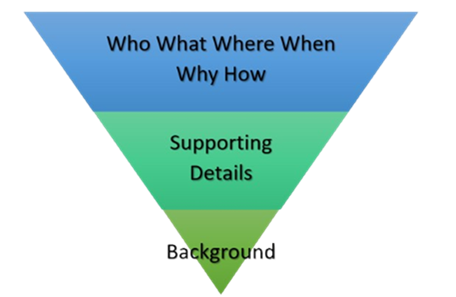(日本語ブログ:日本語の文章を直訳の英語で表現するのが容易ではない最大の理由日本語の文章を直訳の英語で表現するのが容易ではない最大の理由|One World Link)
Struggling with writing clear, concise, and engaging corporate communications?
In Japanese writing, the traditional 起承転結 (introduction, development, turn, and conclusion) structure builds up to the key point. But in English, readers often expect the main message upfront, especially in global IR communications. Whether you’re drafting a press release, business report, or blog post, the inverted pyramid format helps you organize ideas effectively and immediately capture your audience’s attention.
What is the inverted pyramid format?
The inverted pyramid format presents information in order of importance. Purdue OWL Online Writing Lab writes that (the inverted pyramid) “remains one of the most widely used and time-tested structures in mass media writing.” Purdue introduced the inverted pyramid structure as a result of the telegraph, which would first transmit important information in case of transmission loss. The inverted pyramid structure introduces the most critical information first, follows up with supporting details, and ends with background information.
Here is a general image for context.

Pyramid breakdown
- Most Important Information First
Start with the main point or key message. This is often the who, what, when, where, why, and how. - Supporting Details Next
Provide additional context, such as specific examples, explanations, or secondary information. - Background Information Last
Include less critical details or historical context for readers who want more depth.
What does this structure offer?
The biggest advantage of the inverted pyramid structure is that the structure ensures readers grasp the main ideas and critical information quickly.
Process Street, a company that offers solutions to manage business and workflows, published a blog post Inverted Pyramid: Don’t Bury the Lead — Give People What They Want (Fast)! This post touches on plummeting user concentration rates in this time of fast-paced communications, suggesting that the inverted pyramid can “supply global audiences with the news they do want to hear – and quickly.”
How does the inverted pyramid compare with Japanese writing methods?
For business English writing, the inverted pyramid structure is advantageous, offering readers (often busy investors and stakeholders) the main information upfront.
For comparison, let’s take a look at 起承転結. While each company may adhere to different standards and implement different writing strategies, a common theme in Japanese writing is the concept of 起承転結. This writing style features a four-part structure consisting of an introduction (起), the development (承), a twist (転), and a conclusion (結).
For example, a common sentence structure I find myself reading in Japanese financial statements or briefings looks something like this →
Ex. Q2は〇〇需要の落ち込みにより、売上が前年を下回ったものの、気温の変動に伴いQ3の売上は前年同比で二桁増収へ転じ、過去最高を記録した。
(Direct translation: Although Q2 sales were lower than the previous year due to a drop in ●●demand, Q3 sales turned to a double-digit increase year on year due to fluctuating temperatures, reaching a record high.)
If we keep the original Japanese structure in the English translation, we only find out the main information (achieving record-high profits) at the very end. The original Japanese structure also results in a highly complex and difficult-to-understand sentence that distracts from the main point.
Now, let’s take a look at how this English sentence would look if written with the inverted pyramid.
Q3 sales reached a record high, rising by double digits year over year due to fluctuating temperatures. This growth marked a rebound from Q2 when weaker demand for ●● led to a year-on-year decline in sales.
Notice the difference? This version is both concise and clear, while also accommodating busy readers who skim for the main information.
| Format | Structure | Best For | Advantages | Disadvantages |
|---|---|---|---|---|
| Inverted Pyramid | Most important information first, followed by details and background. | News articles, press releases, business updates. | Grabs attention quickly, easy to skim, editors can trim from the bottom. | Can feel abrupt or lacking depth at the end. |
| 起承転結 | Four-part structure: Introduction (起), Development (承), Twist (転), Conclusion (結).Introduction, body paragraphs with supporting details, and conclusion. | Business proposals, strategic presentations, formal communications in Japanese contexts. Academic writing, opinion pieces, in-depth analysis. | Provides a culturally resonant, logical flow in Japanese that gradually builds context and argument; enhances persuasiveness. Allows for thorough exploration and persuasion. | May be less direct for audiences accustomed to Western styles; can be verbose if not carefully managed. Readers may not immediately find the key information. |
Process Street mentions additional benefits of using the inverted pyramid structure in business contexts, including improvements in readability, SEO, and accessibility.
Final thoughts
The inverted pyramid format is your key to clear and impactful business communications. Start using this structure in your writing today to engage your audience and make your message impossible to miss.
Contact One World Link for a free writing evaluation (available for Japanese corporations only) and let us help you create clear and concise translations for global audiences.
Jessica Azumaya
最新記事 by Jessica Azumaya (全て見る)
- Are You Using Incorrect English in Japanese Design? - 12月 15, 2025
- One Easy Way to Make Your English Writing Appear More Natural - 12月 13, 2025
- Why Using a Consistent Theme for Integrated Reports Strengthens Your Global Message - 12月 11, 2025
- Why Vertical Japanese Text Design Ruins English Reports - 12月 9, 2025
- Writing Is More Than ‘What’ You Say - 12月 5, 2025

